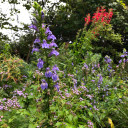
Lobelia siphilitica - GREAT BLUE LOBELIA
A very common, but also widely underused perennial! The Great Blue Lobelia prefers sun or partial shade and a moist location. It blooms in late summer, with 1 1/2- to 3- foot spikes of deep blue flowers.
The value of this plant comes from its late blooming period, plus it's surprisingly adaptable to common garden soils or clay with average moisture (it can survive late summer droughts pretty well, especially in clay soils). It is not too long-lived, but self-seeds reliably. Great as a cut flower, too.
Looks perfect in any perennial border, wild garden, native plant garden, woodland garden, naturalized planting, and along ponds or streams. A lovely color combination can be made with Lobelia cardinalis; other great perennial companions are hardy Geraniums, Hemerocallis, Hosta, Persicaria, Phlox paniculata, Physostegia, and Sanguisorba.
The species name of siphilitica came from a prior medicinal use of the plant in the treatment of venereal disease.
Blooming Time: July to September
Size: 30” tall x 18” wide
USDA Zones: 4 to 9
Culture: full sun, half shade, very light or dappled shade . Even though this perennial comes from wet soils, it grows very well in average, moist garden soils and can be surprisingly drought tolerant
Moisture Needs: moderately moist, moist, wet
Origin: Eastern North America (see the USDA distribution map), grows in moist to wet locations along streams, springs, swamps, meadows and in low wooded areas
Deer/Rabbit Resistant: yes / yes
Attracts Butterflies or Pollinators: offers nectar and pollen for bumblebees, other long-tongued bees, large butterflies and Halictid bees. Caterpillars of the Pink-washed Looper Moth feed on the leaves.
Attracts Hummingbirds: only occasionally
Pot Size: 3.5” x deep 5” pot

Lobelia siphilitica - GREAT BLUE LOBELIA
A very common, but also widely underused perennial! The Great Blue Lobelia prefers sun or partial shade and a moist location. It blooms in late summer, with 1 1/2- to 3- foot spikes of deep blue flowers.
The value of this plant comes from its late blooming period, plus it's surprisingly adaptable to common garden soils or clay with average moisture (it can survive late summer droughts pretty well, especially in clay soils). It is not too long-lived, but self-seeds reliably. Great as a cut flower, too.
Looks perfect in any perennial border, wild garden, native plant garden, woodland garden, naturalized planting, and along ponds or streams. A lovely color combination can be made with Lobelia cardinalis; other great perennial companions are hardy Geraniums, Hemerocallis, Hosta, Persicaria, Phlox paniculata, Physostegia, and Sanguisorba.
The species name of siphilitica came from a prior medicinal use of the plant in the treatment of venereal disease.
Blooming Time: July to September
Size: 30” tall x 18” wide
USDA Zones: 4 to 9
Culture: full sun, half shade, very light or dappled shade . Even though this perennial comes from wet soils, it grows very well in average, moist garden soils and can be surprisingly drought tolerant
Moisture Needs: moderately moist, moist, wet
Origin: Eastern North America (see the USDA distribution map), grows in moist to wet locations along streams, springs, swamps, meadows and in low wooded areas
Deer/Rabbit Resistant: yes / yes
Attracts Butterflies or Pollinators: offers nectar and pollen for bumblebees, other long-tongued bees, large butterflies and Halictid bees. Caterpillars of the Pink-washed Looper Moth feed on the leaves.
Attracts Hummingbirds: only occasionally
Pot Size: 3.5” x deep 5” pot
Customer Reviews
-
Great blue lobelia
Arrived in good condition. Roots were very pot bound. Easy to remedy by slicing bottom of root ball, scoring the rootball sides and teasing the roots prior to planting
-
Lobelia siphilitica
The lobelia plants arrived carefully packaged in great condition and were very nice size plants.







